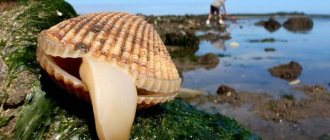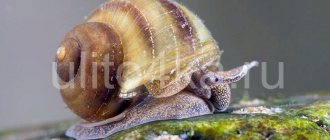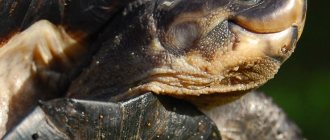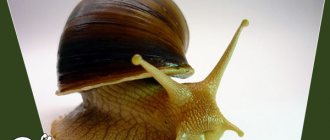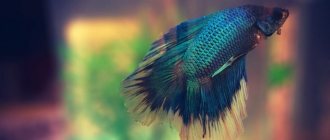Pearl mussels are more primitive relatives of pearl mussels. In pearl mussels, the lateral teeth are reduced, and the gills on the dorsal side are not fused.
Common pearl mussels have thick, massive shells; the shell length is usually 12 centimeters. Often the tops of the shells are eaten away. On the inside, the shell has a pearlescent layer of brilliant white hue.
Pearl mussel (Margaritifera margaritifera).
Where does the pearl oyster live?
Pearl mussels live in small rivers in northern Russia: on the Kola Peninsula, in Karelia, in the Arkhangelsk region, and are sometimes found in the Valdai Hills.
Common pearl mussels, unlike toothless pearl mussels and pearl mussels, do not live even in slightly silted soil; they settle on a fine rocky or sandy bottom, and the water should be clear, rich in oxygen and of moderate temperature. In some reservoirs they are found in large numbers: there can be up to 50 mollusks per 1 square meter.
Most pearl mussels are found on river rapids, under stones that reduce the strength of the current. In such places, about 16-20 individuals can accumulate on one stone at a time.
Pearl mussels live in small rivers.
Pearl mussels grow glochidia on their gills, which, emerging from the mother’s body, parasitize fish, among which minnows are preferred.
Today, the habitat of common pearl mussels has been significantly reduced, since these creatures are very demanding about the cleanliness of water bodies and the oxygen content in them. These mollusks cannot be found in urban rivers polluted by sewage, or in rivers near which there are factories, since the chemical composition of the water in them changes. The habitat of pearl mussels is also shrinking due to swamping of many areas.
It is extremely difficult to restore the population, this is due to the slow growth of these mollusks. Pearl mussels reach only 0.5 centimeters in the 1st year of life, by the 5th year they grow to 2 centimeters, by the 7-8th year - to 3-4 centimeters, they reach 6 centimeters only by 10 1st year of life, and then annually increase in size by only 1 millimeter. The shell length of the largest specimens is only 12-13 centimeters, while their age reaches about 70 years.
The shell length of the largest pearl mussels is 12-13 cm.
Rejuvenation process
Freshwater pearl mussels are an amazingly strong organism: they can live 150-200 years without aging. They can only die from starvation - if the shell becomes so large that the mollusk cannot move it from its place. The most interesting thing is that with age, freshwater mollusks only gain strength: they gain the ability not to breathe for more than a month and to starve for two years. But this mollusk demonstrates absolutely incredible talents while living in symbiosis with salmon. The fact is that it helps fish increase their life expectancy several times! Salmon have a genetic program that shuts down the immune system immediately after spawning, resulting in the death of the fish. But a small mollusk can disrupt this program. This happens as follows: as soon as the fish arrives to spawn, the pearl mussel shoots at it with myriads of its larvae, which attach to the gills and form a benign tumor. Future mollusks develop in it, and fish become completely subservient to them. In a yet unknown way, mollusks turn off the genetic program for the death of salmon after spawning, block its need for food and do not release it into the sea. After which the salmon lives in the river for a whole year, bearing pearl mussel larvae. By the end of the period, the fish is alive, but looks like a skeleton, because it can only feed in the sea. But after a year, when the mollusk larvae are ready for independent life, they secrete a special secretion that instantly dissolves the tumor, and the salmon can live peacefully further until the next spawning. Some salmon undergo such rejuvenating “injections” several times during their lives and, as a result, far outlive their natural lifespan. Scientists believe that if you understand how the mollusk turns off the program of rapid aging and death in fish, then you can get an effective remedy against old age.
Magazine: Secrets of the 20th Century No. 36, September 2009 Category: Our neighbors on the planet Author: Elena Alexandrova
Tags: Secrets of the 20th century, fish, immortality, pearls, pearl oyster, mollusk, shell
- Back
freshwater pearls
At all times, these mollusks were mined for river pearls, which grow in the mantle cavity of the body of these creatures. How are freshwater pearls formed? If a foreign body, for example a grain of sand, penetrates between the valves of a mollusk, it irritates the tissues of the mollusk, resulting in the release of a hardening pearlescent substance from the skin. In other words, the same mother-of-pearl from which the inner layer of the shell is formed is released. A grain of sand is covered with mother-of-pearl on all sides, thus forming a small pearl. As the mollusk grows, the pearl inside it also grows, and since the growth of these mollusks is very slow, therefore, the pearl increases in size extremely slowly: it turns into a pea in about 12 years, and by 30-40 years of the mollusk’s life , it reaches a size of 8 millimeters.
Pearl mussels are harvested for freshwater pearls.
Freshwater pearls have always had high commercial value. It is known from ancient chronicles that pearl embroidery was practiced back in the 10th century, but most likely it existed much earlier. At the royal courts there were specialized workshops in which craftswomen were engaged in weaving precious lace from pearls. In tsarist times, even horse blankets were embroidered with pearls. The clothes of wealthy ladies were strewn with pearls, and young girls wove strands of pearls into their braids.
Tsar Peter I was the first to take up the protection of pearls. To prevent the settlements of pearl mussels from being completely devastated, the tsar issued a decree according to which it was forbidden to catch young mollusks. And during the reign of Empress Elizabeth, even more attention began to be paid to this problem. The rivers in which pearl mussels were caught began to be protected.
Pearls were mined at public expense, but the monopoly on this type of activity greatly ruined the treasury, so it was soon completely abolished. As a result, private individuals took over the fishery, which significantly reduced the population of these slow-growing mollusks. Today, all types of freshwater pearl mussels are very rare, they are in danger of complete extinction, therefore the common pearl mussel is recommended for inclusion in the Red Book.
Freshwater pearls have always had a high value.
Several species of pearl mussels live in the Far East, for example, the Daurian pearl mussel lives in the Amur River basin. This species has a large shell, reaching a length of 10-17 centimeters, it has whitish-pink nacre. The Middendorf pearl mussel lives in Kamchatka; its shell does not exceed 8-9 centimeters; it has whitish-pink or red mother-of-pearl. In the mountain rivers of Sakhalin and on the southern islands of the Kuril ridge, the Sakhalin pearl mussel is found; its shell reaches 10-12 centimeters, and the nacre layer has a red, pink or purple color. All of the above species of pearl mussels are included in the Red Book.
If you find an error, please select a piece of text and press Ctrl+Enter.
Trades
But the fashion for pearls does not go away, and one hundred and fifty years is a considerable period, and therefore divers from pearl fisheries work tirelessly. Pinctads, and other pearl-bearing mollusks, rarely live alone. They usually form fairly dense settlements - pearl banks. They do not like fresh water, and therefore settle far from river mouths. The main fisheries for sea pearls are located on the island of Sri Lanka in the Gulf of Manara, in the Red Sea, the Sulu Sea (between the Philippines and the island of Kalimantan), off the coast of Australia, Japan, in the Persian Gulf, along the coasts of Venezuela, Panama and Mexico and on Margarita Island in Caribbean Sea. The pearls themselves differ in the location of the pearl jars: pearls found near the Australian coast are white; off the coast of Panama - golden. Pearls caught in areas between Japan and India have a strong luster and a pinkish tint. In these fisheries, pearl mussel fishing has been going on for several centuries, but it looks about the same as it did centuries ago: a pearl fisher, armed only with a knife, goes to the depths and stays there for about a minute, collecting shells in a special basket. No mechanics - just like in the time of Columbus.
Notes
- ↑ 12
Annotated list of rare and endangered species of invertebrate animals, specially protected within Russia // 2003* Russia* Red List of Specially Protected Rare and Endangered Animals and Plants. (2nd issue). Part 2. Invertebrate animals (Red Book Bulletin, 2/2004 (2008)) / rep. ed. V. E. Prisyazhnyuk. - M.: Red Book Laboratory of the All-Russian Research Institute for Nature Conservation, 2004 (2008). - P. 94. - 512 p. — ISBN 978-5-9243-0158-7 Full text Archived copy of October 24, 2021 on the Wayback Machine - Zatsepin V.I., Filatova Z.A., Shileiko A.A. Class Bivalves (Bivalvia) // Animal Life. Volume 2. Mollusks. Echinoderms. Pogonophora. Chaetognathous. Hemichordates. Chordata. Arthropods. Crustaceans / ed. R.K. Pasternak, ch. ed. V. E. Sokolov. — 2nd ed. - M.: Education, 1988. - P. 82. - 447 p. — ISBN 5-09-000445-5
- ↑ 123
Zhadin V.I. Mollusks of fresh and brackish waters of the USSR. M.-L.: USSR Academy of Sciences, 1952, 376 p. - ↑ 12345
Zhadin V.I. Fauna of the USSR. Shellfish. Family Unionidae. M.-L.: USSR Academy of Sciences. 1938, vol. 4, issue. 1, 170 p. - Zyuganov V.V.
Arctic long-lived and southern short-lived mollusks pearl mussels as a model for studying the basis of longevity. (Russian) // Successes gerontol. : magazine. - 2004. - T. 14. - P. 21-31. - André Gomes-dos-Santos
et al. The Crown Pearl: a draft genome assembly of the European freshwater pearl mussel Margaritifera margaritifera (Linnaeus, 1758), December 06, 2021 (ResearchGate) - Scientists from Arkhangelsk have deciphered the genome of mollusks - contemporaries of dinosaurs, 01/13/2021
- ↑ 123
Zhadin V.I. Freshwater mollusks of the USSR. L.: Lensnabtehizdat, 1933, 232 p. - Parasite-benefactor (undefined)
(inaccessible link). Access date: July 17, 2012. Archived October 6, 2011.
Difficulties of growing
In order for the decorative yarrow to always please the gardener, it is necessary to carry out weeding .
This is necessary to prevent the Pearl Oyster from turning into a weed. Getting rid of self-seeding is quite simple - you should remove the inflorescences in time after flowering.
Pearl mussel blooms profusely under good conditions, which increases the risk of stems breaking or plant lodging due to excessively heavy double flowers. To prevent this, it is enough to make small supports that can be hidden in the density of the bush.
How to deal with pests and diseases?
Yarrow Pearl mussel is considered resistant to both diseases and pests. However, problems may arise when growing the plant together with some other plantings.
For example, when adjacent to beets, yarrow may suffer from the striped beet weevil. The pest attacks not only the leaves, but also the cuttings of the plant. Its larvae also damage the root system.
To combat adult individuals, it is necessary to spray yarrow:
- phthalophos;
- bazudine;
- chlorophos.
To get rid of the larvae, it is necessary to treat the soil under the plant with hexachlorane.
Flower care
Despite the fact that the Pearl mussel is considered an unpretentious plant that has increased resistance to pests and diseases, even it requires proper planting and care :
- Get rid of weeds. A large number of excess plants can “strangle” the decorative yarrow.
- Water regularly. At least once a week during hot periods.
- Feed periodically. Up to three times per season: before the flowers appear, during and after. Nitrogen fertilizers should be used in the spring months, then the bush will be more lush.
If you want the bush to be more stocky and flowery, you should pinch it in the spring.
